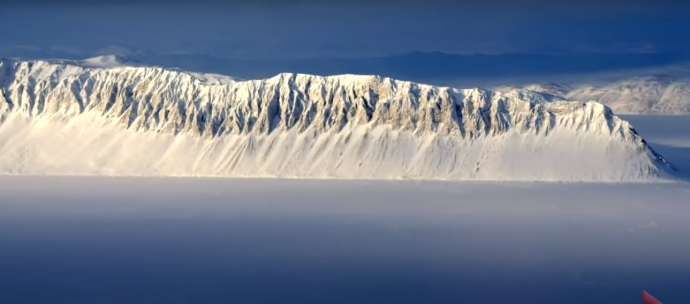Časoris is an online newspaper aimed at children. Each week we’ll take an article and post it here as a Slovene-English dual text.
Zbogom, ledena plošča!
Goodbye, ice sheet!
Written by Romana Dobnikar Šeruga, translated by JL Flanner & G Translate
Še zadnja nedotaknjena ledena plošča na kanadskem severu je izgubila skoraj polovico svoje površine in se zrušila v morje.
The last untouched ice sheet in the Canadian north lost almost half of its surface and crashed into the sea.
»Nadpovprečne temperature zraka, vetrovi blizu obale in učinki odprtega morja so recept za odlom ledene plošče,« je dogodek na Twitterju komentirala kanadska služba za spremljanje stanja ledu (Canadian Ice Service).
"Above-average air temperatures, winds near the coast and the effects of the open sea are the recipe for breaking the ice sheet," the Canadian Ice Service commented on the event on Twitter.
Satellite animation, from July 30 to August 4, shows the collapse of the last fully intact #iceshelf in #Canada. The Milne Ice Shelf, located on #EllesmereIsland in #Nunavut, has now reduced in area by ~43%. #MilneIceIsland #seaice #Arctic #earthrightnow #glacier pic.twitter.com/jjs1gawoxA
— ECCC Canadian Ice Service (@ECCC_CIS) August 4, 2020
Novica žal ni nepričakovana. Arktiko, območje med severnim tečajem in severnim tečajnikom, je tudi to poletje zajel vročinski val in po njej pustošijo številni gozdni požari. V sibirskem mestu Verhojansk so leta 1892 namerili najnižjo temperaturo na severni polobli, minus 68 stopinj Celzija. 20. junija letos pa so v do zdaj najhladnejšem naseljenem kraju na svetu zabeležili rekordno temperaturo: 38 stopinj Celzija. To je kar 18 stopinj več, kot je najvišja povprečna junijska dnevna temperatura.
Unfortunately, the news is not unexpected. The Arctic, the area between the North Pole and the North Circle, has also been hit by a heatwave this summer and is ravaged by numerous forest fires. In the Siberian city of Verkhoyansk, the lowest temperature in the northern hemisphere, -68° Celsius, was measured in 1892. On June 20 this year, a record temperature was recorded in the coldest inhabited place in the world so far: 38° Celsius. That’s as much as 18 degrees more than the highest average June daily temperature.
Julija je bilo arktičnega morskega ledu najmanj v zadnjih 40 letih. Območje večnega ledu se zadnjih 30 let segreva dvakrat hitreje od globalnega povprečja. Naraščajoče temperature talijo arktični morski led. Odprta voda, ki pri tem nastane, pa vpije še več sončnih žarkov, kar še bolj ogreje Arktiko. In začaran krog je sklenjen.
In July there was the smallest amount of Artic sea ice for the last 40 years. The permafrost has been warming twice as fast as the global average for the past 30 years. Rising temperatures are melting Arctic sea ice. The resulting open water absorbs even more sunlight, further warming the Arctic. And the vicious cycle is closed.
A ne talijo se samo mogočne ledene plošče in ledeniki, topi se permafrost, trajno zamrznjena tla, v katerih se skrivajo tudi do sto tisoč let stari virusi in bakterije. Kaj bi se zgodilo, če bi se odmrznili povzročitelji kakšnih starih nalezljivih bolezni? Temu problemu v času pandemije novega koronavirusa znanstveniki namenjajo veliko pozornosti.
But it's not just mighty ice sheets and glaciers that are melting, permafrost is melting – permanently frozen soils that contain viruses and bacteria that are up to a hundred thousand years old. What would happen if the causes of some old infectious diseases thawed? Scientists are paying close attention to this problem during the new coronavirus pandemic.
»Bakterije lahko preživijo dolgo časa, to je v znanstvenih krogih sprejeto dejstvo. Vprašanje je le, kako dolgo. Milijon let? Petsto tisoč let? Petdeset tisoč let?« se za Unearthed sprašuje virolog Jean Michel Claverie.
“Bacteria can survive for a long time, this is a fact accepted in scientific circles. The question is just how long. A million years? Five hundred thousand years? Fifty thousand years? ”Asks virologist Jean Michel Claverie for Unearthed.
Če bo šlo tako naprej, na Arktiki leta 2050 ne bo več ledu.
If it goes on like this, there will be no more ice in the Arctic in 2050.
Read more stories and improve your Slovene at Časoris, while all our dual texts can be found here.







